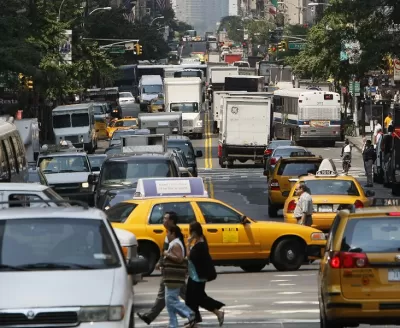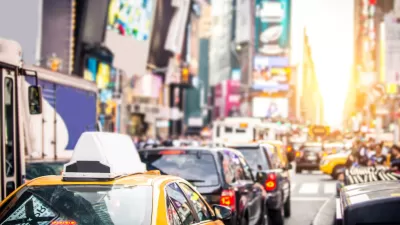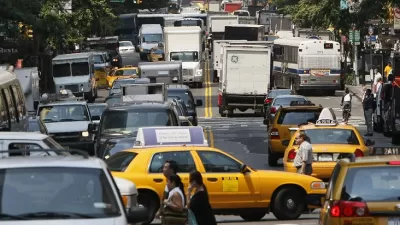The city's plan to charge vehicles entering Manhattan's central business district could reduce traffic and raise $1 billion a year for the city's transportation infrastructure.

In an op-ed in the New York Daily News, Betsy Plum and Kate Slevin argue that New York City's long-awaited plan to institute congestion pricing for vehicles entering Manhattan's central business district is "a welcome milestone" for a strong regional recovery.
"Now that the doors are open for quick action, the MTA should immediately begin determining the nuts and bolts of what New York’s program looks like — fixing how much tolls will cost, whether they’ll vary by time of day, who pays what," write Plum and Slevin. The authors contend that, "[w]ith forward thinking and hard work that starts now," the city could start its program and start earning revenue in as little as a year.
If instituted, the program would follow in the footsteps of London, Singapore, Stockholm, and other traffic-choked cities. "Congestion pricing is projected to raise about $1 billion annually for new subway signals, cars, elevators, buses and commuter rail. It will alleviate congestion worth an estimated $20 billion annually to residents." Additionally, the reduced traffic could lead to faster buses, "quicker emergency response times, less pollution, fewer carbon emissions, less chance of deadly collisions, less of a burden on businesses and customers and less stress for businesses, drivers, commuters and residents."
FULL STORY: Congestion pricing, more than ever

Study: Maui’s Plan to Convert Vacation Rentals to Long-Term Housing Could Cause Nearly $1 Billion Economic Loss
The plan would reduce visitor accommodation by 25,% resulting in 1,900 jobs lost.

North Texas Transit Leaders Tout Benefits of TOD for Growing Region
At a summit focused on transit-oriented development, policymakers discussed how North Texas’ expanded light rail system can serve as a tool for economic growth.

Why Should We Subsidize Public Transportation?
Many public transit agencies face financial stress due to rising costs, declining fare revenue, and declining subsidies. Transit advocates must provide a strong business case for increasing public transit funding.

A Visual Celebration of Manhattan’s Chinatown Elder Community, Through Food
Lanterns, cafeteria trays, and community connection take center stage in this stunning photo essay.

How to Make US Trains Faster
Changes to boarding platforms and a switch to electric trains could improve U.S. passenger rail service without the added cost of high-speed rail.

Columbia’s Revitalized ‘Loop’ Is a Hub for Local Entrepreneurs
A focus on small businesses is helping a commercial corridor in Columbia, Missouri thrive.
Urban Design for Planners 1: Software Tools
This six-course series explores essential urban design concepts using open source software and equips planners with the tools they need to participate fully in the urban design process.
Planning for Universal Design
Learn the tools for implementing Universal Design in planning regulations.
City of Santa Clarita
Ascent Environmental
Institute for Housing and Urban Development Studies (IHS)
City of Grandview
Harvard GSD Executive Education
Toledo-Lucas County Plan Commissions
Salt Lake City
NYU Wagner Graduate School of Public Service





























